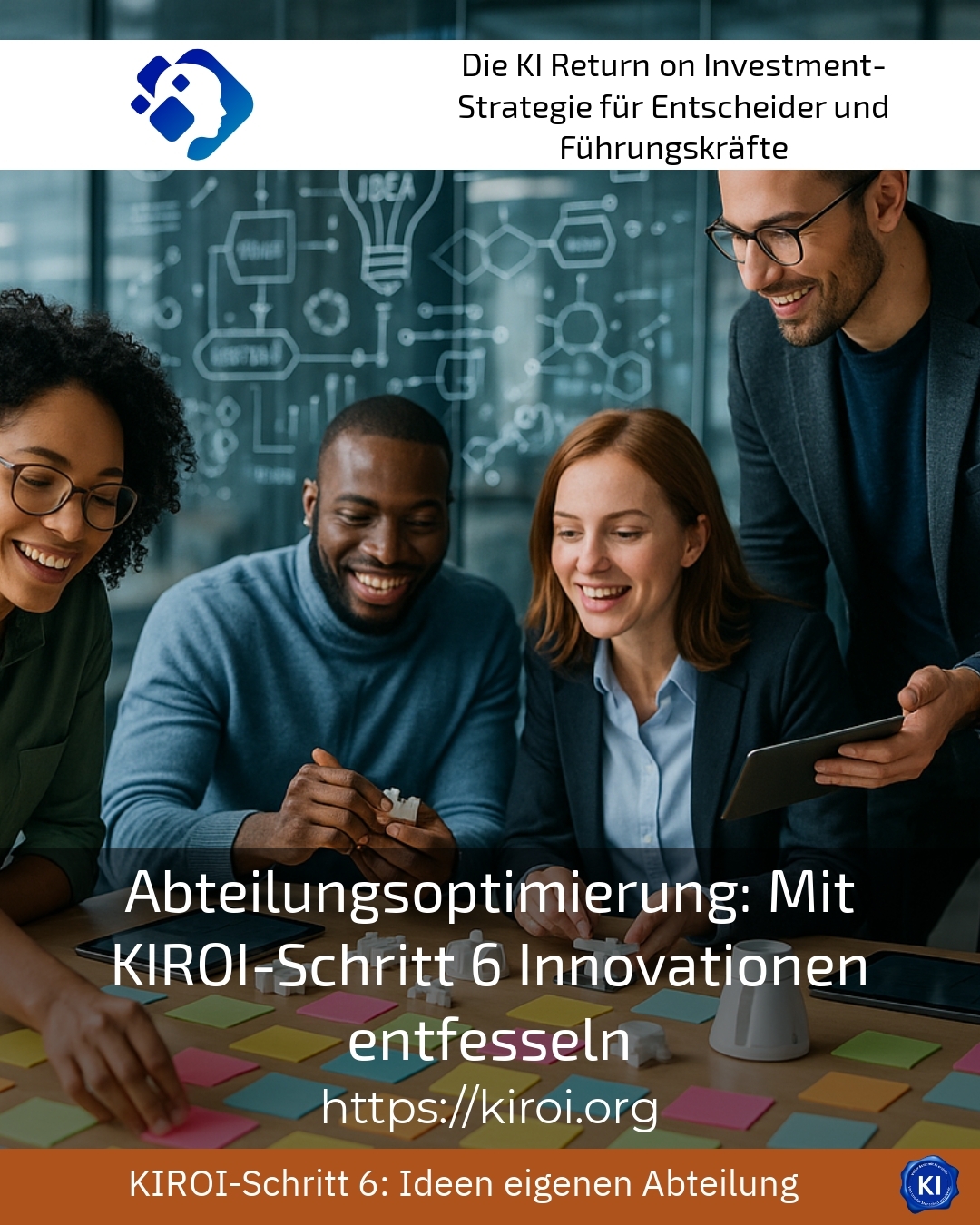Targeted departmental optimisation plays a decisive role when it comes to making internal structures more efficient and unleashing innovative power. Creative potential can be systematically activated, particularly with the extended set of tools in KIROI step 6. This is not just about collecting ideas, but about supporting all those involved on the path to sustainable improvements and innovative solutions.
How KIROI Step 6 supports departmental optimisation
Many companies are finding that pure process optimisation is often not enough to remain competitive in the long term. The sixth step of the KIROI approach offers a tried and tested method for releasing the power of innovation in departments in a targeted manner. The combination of creativity techniques and structured evaluation generates new impulses that sustainably support departmental optimisation.
For example, a marketing team at a service provider uses KIROI Step 6 to generate new product ideas in moderated innovation workshops. Brainstorming sessions are held first to create diversity before tools such as the morphological box are used to realistically assess feasibility. This results in practice-orientated solutions that expand the portfolio and increase efficiency at the same time.
In the financial sector, a company introduced digital automation ideas with the help of KIROI Step 6. The work processes in the back office were shortened and more strongly digitalised thanks to the new approach. The innovation process was accompanied not only by creativity, but also by methodical analysis, which promoted the acceptance and sustainability of the implementation.
A medium-sized mechanical engineering company combines KIROI Step 6 with the Six Sigma method and was thus able to successfully establish quality innovations. Quality deficits were systematically identified and improved through creative suggestions. Departmental optimisation was supported by this methodical mix and led to a noticeable reduction in rejects and optimised processes.
BEST PRACTICE with one customer (name hidden due to NDA contract) shows how an industrial company used KIROI Step 6 to encourage all employees to actively contribute ideas for process improvement. This resulted in new product innovations and numerous work steps could be organised more efficiently. The incentive provided by the participative approach sustainably increased the culture of innovation.
Actively shaping departmental optimisation: Combining creativity and structure
The challenge of departmental optimisation often lies not only in discovering creative potential, but also in developing it in a targeted and structured manner. KIROI Step 6 combines proven creativity techniques with analytical evaluation schemes. Brainstorming, mind mapping or design thinking, for example, are used to promote new ideas. A systematic evaluation system then supports the selection of the best suggestions.
An example from the automotive supply industry shows how lean management was combined with KIROI Step 6 to both reduce waste in the processes and develop innovative product improvements. Departmental optimisation was thus approached in a two-pronged manner: Efficiency gains and innovative strength were increased simultaneously.
An education provider is also using KIROI Step 6 to adapt digital learning formats in line with the times. The challenge was to react quickly to changing market needs. Targeted workshops were used to develop new concepts and subsequent test phases were implemented with the support of employees. The optimisation of the department benefited from the close involvement of a wide range of perspectives.
One IT company, on the other hand, relied on KIROI Step 6 to quickly rectify technical errors using alternative solutions. This structured approach significantly increased system availability and showed how innovation processes within departments can be combined technically and organisationally.
Practical tips for successful implementation in department optimisation
1 ** Actively involve teams:** Motivate all employees to contribute their ideas. This increases acceptance and creates a feeling of participation.
2 **Use creativity techniques in a targeted way:** Use brainstorming, mind mapping or the morphological box to generate ideas in a variety of ways and evaluate them in a structured way.
3. support step-by-step implementation:** Help teams to prioritise the best ideas and implement them with clear milestones.
4. combine techniques:** Combine methods such as Lean Management or Six Sigma with KIROI Step 6 to simultaneously optimise processes and provide innovative impetus.
5 **Promote communication and transparency:** Keep the workforce informed and avoid obstacles by talking openly about goals and challenges.
My analysis
Departmental optimisation through KIROI Step 6 provides an effective framework for actively shaping innovation processes in companies and achieving sustainable improvements. The combination of creativity and systematic structuring leads to teams better realising their potential. This not only addresses short-term challenges, but also supports long-term innovation strategies. In this way, departmental optimisation becomes an integral part of modern corporate development.
Further links from the text above:
[1] Process optimisation: definition, methods, examples
[2] Department optimisation: With KIROI step 6 to innovative ...
[3] Process optimisation: definition, methods & implementation
[4] Department optimisation: With KIROI step 6 to top ideas
[5] Process optimisation: definition, objectives, phases, procedure
[6] Developing innovations in the company | 6 steps
[8] Unleashing departmental innovation: With KIROI Step 6 to ...
[10] Innovation strategy: KIROI Step 6 - Ideas for your ...
[12] Mastering idea management: KIROI step 6 for your ...
[14] Innovation strategy: Use KIROI step 6 for your department
For more information and if you have any questions, please contact Contact us or read more blog posts on the topic Artificial intelligence here.















